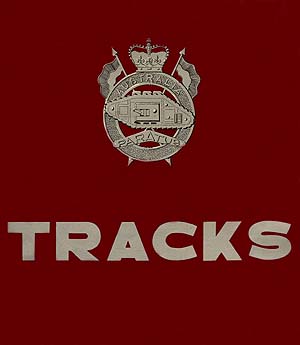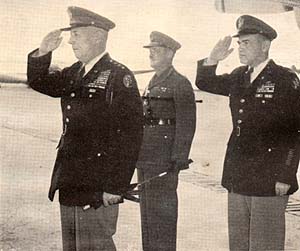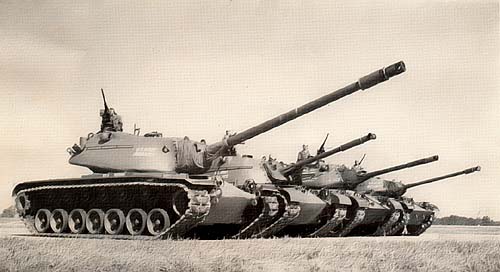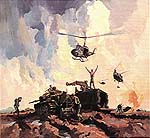Tracks Magazine - August 1955


A couple of decades ago I was travelling through northern NSW and called in to see Archie McDonald, an old 1 Armoured Regiment LAD mate. Archie had kept his copy of the first issue of the Regiment's glossy magazine, Tracks — August 1955. It is this magazine that is re-produced below
Tracks Magazine
Index
Foreword Preface Tracks To Tradition Keep An Open Mind Review of Squadron Activities Regimental Headquarters Headquarters Squadron Reconnaissance Troop A Squadron Notes B Squadron Notes Nucleus Squadron Regimental Training Troop Light Aid Detachment, RAEME Signals Troop, RASigsIndex (cont)
Review of Allied Armour Tanks in The Jungle Korean Sidelights Equipments 1954 .. A Royal Occasion On Parade Elevating Gear Officers' Mess Notes Sergeants' Mess Notes In The Realm of Sport It Could be You The Adjutant's Dilemma While Others Sleep [et al] Beauchamps Own Epilogue Free Verse From A Free Thinker
THE PRINCIPLES OF THE EMPLOYMENT OF ARMOUR

Commanding General, United State Army, Pacific.
The author of this authoritative article is an acknowledged expert in the Principles and Employment of Armour, which comes direct to this Journal for publication. "I am honoured to be asked to write an article for your Regimental Journal" is the generous comment of Lt.-General Bruce C. Clarke.
Recently in Australia as the Guest of Honour for the Battle of the Coral Sea commemorations, our distinguished visitor was met at Essendon Airport by a Guard of Honour mounted by the first Armoured Regiment, R.A.A.C. He writes, "I well remember the fine Guard of Honour mounted by your Regiment at Essendon Airport. It is always a pleasure to see such excellent troops and to greet veterans who played such a gallant role in the defeat of our common enemy during the past decade." Our photograph shows Lt.-General Bruce C. Clarke receiving the General Salute at Essendon Airport.
INTRODUCTION
The last ten years have seen great changes in the art of warfare. Air power has profoundly changed our military concepts, but it has not eliminated the need for ground forces. Rather, it has served to weld more closely together the several armed services into an overall,
balanced national defence team wherein each service aids and is in turn aided by the others in accomplishing a common mission.
On the ground, we have seen more open and fluid warfare, faster movements, more dispersion, more elastic defence formations, and the ability to concentrate great power at a particular point, thereby making the penetration a more commonly used manoeuvre. Armour has been responsible for much of this change. We have witnessed the employment of armoured divisions, armoured corps and armoured armies. The new type field army of the American Army is virtually an armoured army. It has approximately 3,500 tanks plus much self-propelled artillery.
The ability to produce the mechanical means of warfare and to employ those means is an outstanding asset of the United States. We must develop and use this asset to offset the advantage of more manpower possessed by our possible opponents. The use of armour is in furtherance of that concept. It is also in furtherance of our efforts to reduce casualties on the battlefield.
Armour is the arm of mobility, armour-protected firepower, and decisive shock action. Armour is a vital and regular member in the ground team. Armour brings within reach of the field army commander decisive objectives. It provides on the modern battlefield the means by which the army commander can achieve the ultimate objective - destruction of the enemy's will to fight.
There are certain basic principles which govern the employment of armour, but they are no more than guides.
As in the rules of bridge, there is no place in the prin ciples of employment of armour for the words always and never. The successful application of the principles of armoured employment is entirely dependent upon commanders and staffs being flexible in mind, progressive in thought, and liberal in imagination.
ARMOUR PLAYS THE HISTORIC CAVALRY ROLE
Armour fulfills the role in modern warfare that Napoleonic cavalry fulfilled in the 19th Century. It combines great mobility with overwhelming firepower. Cavalry of the later 19th Century and the 20th Century relied primarily on mobility. The firepower of armour must not be overlooked in a consideration of its characteristic of mobility.
For many years armies have sought light, fast-moving units that could upset the time-space factors of the opponents. They were willing to sacrifice some power in order to attain the mobility desired. The cavalry was developed into such a force. With the wide use of the automatic small arms and other effective weapons, and of automotive vehicles, the horse no longer was an effective weapon or an efficient means of transportation on the battlefield. Armour, which combines both high mobility and great firepower has assumed the historic cavalry role in modern war.
ARMOUR IS A STRATEGIC AND TACTICAL THREAT
Armour is a strategic and tactical weapon. Not only is the presence of armour locally a threat to any force, but its capabilities of long movements and prompt commitment make the presence of distant armoured units a threat to any operation.
ARMOUR USES ITS MOBILITY
Armour has been described as mobile, armour-protected firepower. Armour gains its ends through its ability to move and shoot, but above all, to move. An armoured formation many miles away has the ability to intercede in a battle in from 10 to 20 per cent less time than a formation geared to the foot soldier. Armourmoves in a fighting formation. To its speed of movement, then, must be added its ability to be committed promptly from march formation. Mobility in armour is derived not only from tanks, armoured personnel carriers, and self-propelled artillery, but also from the extensive organization of mobile service support at all echelons from company to division.
ARMOUR USES ITS FIREPOWER TO CLOSE WITH THE ENEMY
Armour concentrates its power at the decisive point of action. Armoured formations contain an overwhelming superiority of armour-protected machine guns and cannon. The tank cannon is essentially a weapon used against enemy tanks. It is not artillery. In the application of armour's fire and shock power, artillery and other supporting weapons provide the covering fires which enable the tank machine guns and armoured infantry to close with and destroy the enemy. (The importance or armour in tactical atomic warfare is now widely recognized.)
ARMOUR IN STRENGTH PRODUCES DECISIVE SHOCK EFFECT
The shock or psychological effect which comes to troops on the receiving end of a massed armoured assault is terrific. This effect radiates from the point of attack in concentric semicircles as do the waves from a stone dropped in the water near the edge of a millpond. If the attack is in strength, these shock waves reach to the enemy division, corps, and army headquarters. Shock effect gives armour part of its protection and hastens the disintegration of the enemy force attacked. The shock effect of the mass employment of armour varies as the square or cube of the number of tanks used. Attacking with armored strength too small to produce decisive shock effect often results in great losses and inconclusive results.
ARMOURED FORMATIONS MUST BE FLEXIBLE
Armoured formations are organized in anticipation of success. It is not given to many to be able to visualize all that can happen during a full day of armoured action.Unforeseen contingencies occur. Situations as to terrain, weather, footing obstacles, and enemy cannot be accurately predicted far into the future. A set formation for all situations is a dangerous over-simplification in armoured tactics. The armoured division is designed to fight primarily in two flexibly-organized combat commands. Each is composed from time to time to perform most advantageously the job at hand. Each is commanded by a senior officer who has a staff adequate for handling operations in fast-moving situations and trained to work under mission-type fragmentary orders.
ARMOUR IS A THRUSTING WEAPON
Armour is a weapon which should be thrust quickly through enemy opposition on a relatively narrow front. It is strong as long as it remains in depth. It should not fan out until the opposition has been reduced and powerful enemy counter-reaction is no longer probable.

ARMOUR SEEKS TO ADVANCE IN COLUMN
By advancing to combat in a column of tactical commands, armour is enabled to strike with strength, retain maximum flexibility and control, and reach distant objectives.
Column does not mean that it necessarily moves on a narrow front or on only one road. It may advance on a broad front, but so long as the tactical formations of the division are in column, the commander is ready for any contingency and he can take prompt action without waiting for higher staff reaction and direction. Breaking through and out of an enemy defensive zone in a column of combat commands gives effective power in the break through, and at the same time saves an uncommitted tactical command to handle contingencies and to push on promptly in exploitation.
Against sporadic and weak resistance the two combat commands, and possibly the third, may advance abreast. Such a formation lacks manoeuvrability, flexibility, and sustained strength. When substantial resistance is met or enemy reaction occurs, the division commander employs his tactical commands in the formation most suited to the fulfilment of the mission and if indicated, resumes the column formation.
ARMOUR DRIVES DEEP, ASSEMBLES, AND DESTROYS
An armoured unit commander must observe the principle of the objective. An engineer who wishes to blow down the face of a rock wall bores deep, assembles his charge, and blasts back. He does not place his charge on the face of a wall. Armoured action in similar. What protects armour during this process? The answer is speed, mobility, flexibility, enemy command and staff inertia, and the time and space factors which control the ability to react to such a force. The shock effect of armour reaches even to commanders and staffs and adds to the inertia and the time it takes to react.
ARMOUR NEEDS AND USES MISSION-TYPE ORDERS
Armour should be given a mission and the minimum essential restraining and co-ordinating directions. It should be given the ultimate and decisive objective of the next higher commander so it can take prompt advantage of breaks in order to make great gains.
ARMOURED ACTION CALLS FOR COMBINED-ARMS TEAMWORK IN LOWER ECHELONS
Armoured formations contain, in intimate association, tank, infantry engineer, and artillery elements. This may, and often does, extend down to the company level, where the tank company may have infantry and engineers as well as the ever-present artillery forward observers. Such a situation on the battalion level is usual. It should not be assumed that the tank unit commander is always in command. Often the armoured infantry unit is the basic force to which tanks and engineers are attached, and artillery closely supports.
ONCE THE MOMENTUM OF AN ARMOURED ATTACK IS ATTAINED IT SHOULD BE ALLOWED TO RUN ITS COURSE
An armoured division has enormous momentum when it gets rolling. To damper this by phase lines, limited objectives, and other factors that require high-level decisions in order to continue to advance, dissipates that momentum often faster than does the enemy. Any restriction on movement may provide the enemy with time to react and will frequently result in loss of the initiative.
SUCCESSFUL ARMOURED ACTION IS CHARACTERIZED BY DELIBERATE PLANNING FOLLOWED BY VIOLENT EXECUTION
Armoured action involves large road space, close timing, elaborate supply plans, and extensive plans for maintenance. It involves careful co-ordination and team work with all arms. Artillery, mortar, and air support must be tied in. Communications must be co-ordinated and perfectly established. To do all these requires thorough and deliberate planning.
Once the planning is done, the execution is the pay-of It must be violent if the mobility, firepower, and shock effect desired are to be attained. Half-hearted execution is fatal to the results expected from armoured action.
ARMOURED ACTION REQUIRES SUPPLY AND MAINTENANCE
Adequate plans and facilities for supply and maintenance are essential. It takes over 1500 gallons of fuel to move an armoured division a mile. An armoured unit out of fuel is easily destroyed. Firepower means consumption of large quantifies of ammunition. Food is necessary. In the typical armoured action, supply routes may be cut by enemy action for several days. These contingencies must be foreseen and means provided to assure success. The combat command should carry with it the supplies necessary to reach the final objective and hold effectively.
Tanks and other armoured vehicles require frequent and extensive maintenance. The means are available in the armoured division; the time must be provided if a favourable balance of combat vehicles is to be kept in action against the enemy for sustained operations. The rotation of combat units through the reserve command and the less frequent employment of the reserve com mand as a combat command will provide the necessary time for maintenance.
ARMOURED DEFENSIVE ACTION IS ELASTIC
Armour can conduct and has conducted very effective defences. It does this by being elastic, by rolling with the punches, by counter-attacks, and by anticipatory thrusts to upset an enemy attack forming up. It does not establish a brittle defensive line. It disposes itself in considerable depth. While defence has not been the role normally associated with armour, its capabilities on defence in future warfare must not be overlooked.
ARMOUR AND TACTICAL AIR ARE PARTNERS
It is literally true that armour and tactical air when working close together form a team with enormous power. This partnership does not happen by chance. It takes close association, careful air-ground training, and an intimate understanding of each other's capabilities, limitations, and methods to attain the desired relationship. Armour is the one that needs the support. It must go far more than halfway, if necessary, to effect the partnership.
CONCLUSIONS
The proper application of the principles of the employment of armour will produce outstanding results. They should be considered not as rules, but as guides after carefully estimating the situation. Deliberate planning is needed. Violent execution then pays the dividends. Flexibility of mind, concept, and formations is required of an armoured commander and his staff. He must be willing to take coldly calculated risks. When he holds the cards he must back them up with all his chips, and often he must be willing to put in all his chips when he is not sure that he holds the winning hand.


